Wednesday 22 November, 2017, 15:31 - Broadcasting, Licensed, Pirate/Clandestine
Posted by Administrator
Posted by Administrator
 Wireless Waffle previously sang the praises of the boat trips to visit the Ross Revenge, the home of former radio pirate, Radio Caroline. We also noted that they had been awarded a licence to operate a 1 kiloWatt transmitter on 648 kHz in the Suffolk and north Essex area.
Wireless Waffle previously sang the praises of the boat trips to visit the Ross Revenge, the home of former radio pirate, Radio Caroline. We also noted that they had been awarded a licence to operate a 1 kiloWatt transmitter on 648 kHz in the Suffolk and north Essex area.Well, it seems the engineering bods on the east coast have managed to get it together, and recently test transmissions on 648 kHz were spotted by a number of listeners, such as a DXer in Humberside who posted the video below on YouTube.
Though you may not be able to interpret the waterfall display shown on the video, what you see is the Radio Caroline signal in the middle. The two bright lines either side represent radio stations on the adjacent frequencies (639 and 657 kHz respectively). Normally, for AM broadcasting, each station would be allowed to occupy half of the bandwidth between its assigned frequency and the adjacent channels, meaining that it would extend +/- 4.5 kHz either side of its centre frequency. It is this limitation they gives medium and long wave broadcasting their characteristic 'muddy' sound, as the limitation in spectrum also restricts the amount of audio bandwidth that can be transmitted.
It's therefore notable that the Radio Caroline transmission on 648 kHz extends far closer to the adjacent frequencies than 4.5 kHz. It appears closer to +/- 6.5 kHz wide (or maybe even more). This would allow the station to transmit a wider audio bandwidth and thus sound a little 'brighter' on-air. Such derogations from the norm are not unusual as the medium wave band has become emptier, as there is more space for stations to spread out and sound better.
As an example, the three audio clips below have been filtered with different bandwidths. Just click on the relevant button to hear the difference (note that this doesn't work in all browsers.
| Audio Bandwidth | Play |
|---|---|
| 15 kHz, stereo (FM Stereo) | |
| 6.5 kHz, mono (extended bandwidth AM) | |
| 4.5 kHz, mono (standard bandwidth AM) |
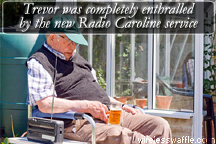 Given that of the neighbouring frequencies, the nearest stations on 639 kHz are in the Czech Republic and Spain (previously crowned the queen of medium-wave broadcasting) and on 657 kHz in Spain (again) and North Wales, it seems unlikely that the additional bandwidth being used by Radio Caroline will give any problems and we are sure that listeners will enjoy the cleaner, brighter sound that they will have on-air.
Given that of the neighbouring frequencies, the nearest stations on 639 kHz are in the Czech Republic and Spain (previously crowned the queen of medium-wave broadcasting) and on 657 kHz in Spain (again) and North Wales, it seems unlikely that the additional bandwidth being used by Radio Caroline will give any problems and we are sure that listeners will enjoy the cleaner, brighter sound that they will have on-air.3 comments
( 1380 views )
| permalink
| 



 ( 3 / 36810 )
( 3 / 36810 )




 ( 3 / 36810 )
( 3 / 36810 )
Wireless Waffle recently spotted that boat trips to see Radio Caroline's ship, the Ross Revenge, were available to book from their web-site (follow the link) and so it seemed like the perfect opportunity to don an anorak and set sail. On the day of the visit, the weather was beautiful, sunny, 26C and the sea was calm, but it isn't always like that. Boarding the Razorbill 3 , the tender which takes you from the jetty at West Mersea out to the Ross Revenge, it was a pleasure to see so many families taking advantage of the weather to go crabbing. The ride out took about 25 minutes and was a delight in itself with the cool sea air rushing past.
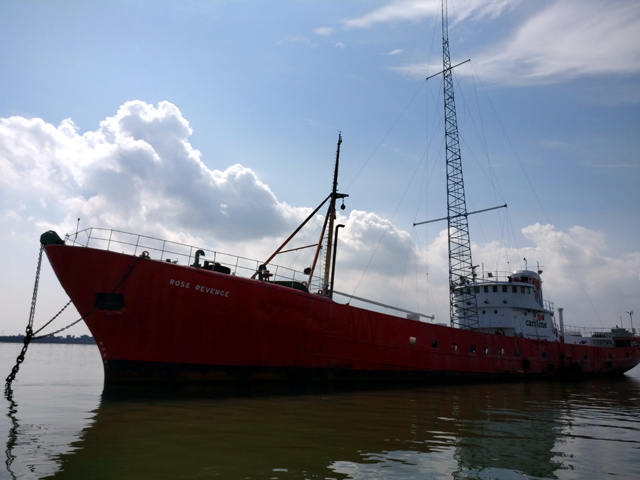 Pulling alongside the boat, it looked exactly as it does in all the postcards, though the current mast is a lot smaller than the 100 metre mast that was in use for transmission during Radio Caroline's heyday. Arrival onto the boat was greeted by a cup of tea and a fig roll in the mess and a description of the history of the boat, which turns out to have been a prize Grimsby-based fishing boat originally made as an Icelandic ice-breaker. Much of the tour of the boat is about the Ross Revenge itself, as well as the catastrophic events of October 1987 which saw the original mast collapse in a storm.
Pulling alongside the boat, it looked exactly as it does in all the postcards, though the current mast is a lot smaller than the 100 metre mast that was in use for transmission during Radio Caroline's heyday. Arrival onto the boat was greeted by a cup of tea and a fig roll in the mess and a description of the history of the boat, which turns out to have been a prize Grimsby-based fishing boat originally made as an Icelandic ice-breaker. Much of the tour of the boat is about the Ross Revenge itself, as well as the catastrophic events of October 1987 which saw the original mast collapse in a storm.
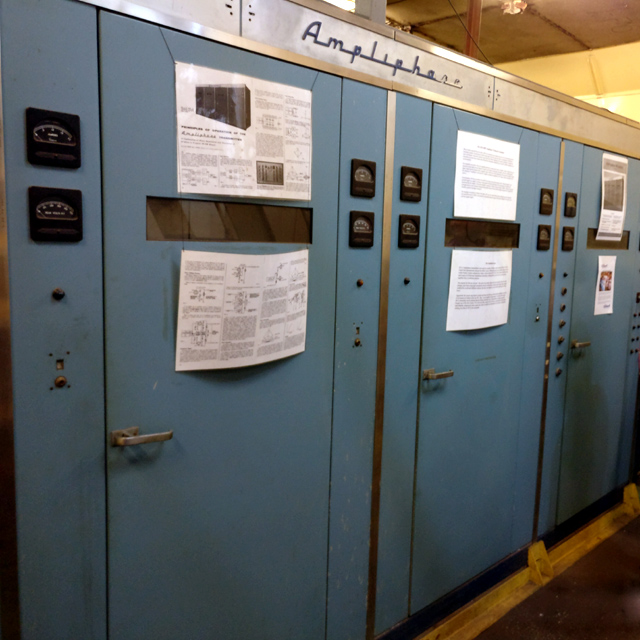 Of course no tour of such an historic ship would be complete without a visit to the studios and the technical facilities such as the engine room, generator room and of course the transmitter room. The 50 kW 'Ampliphase' transmitter consumed nearly 1 tonne of fuel per day to operate so it's no wonder that getting supplies to the boat, including diesel and fresh water, were so critical.
Of course no tour of such an historic ship would be complete without a visit to the studios and the technical facilities such as the engine room, generator room and of course the transmitter room. The 50 kW 'Ampliphase' transmitter consumed nearly 1 tonne of fuel per day to operate so it's no wonder that getting supplies to the boat, including diesel and fresh water, were so critical.
Though the notion of being a pirate at sea may seem romantic, it is clear that the lives of the DJs and other staff must, at times, have been pretty miserable. The cabins below the deck are relatively spartan and if it was blowing a gale, there couldn't have been much to do if you weren't on air.
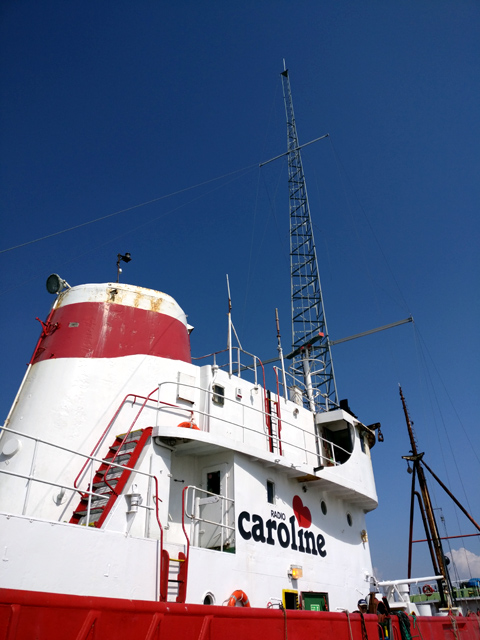 The return from the ship to the shore was equally exhilarating and you left with a lot of respect for those who took to the seas to try and deliver a radio service that filled the gap left by the legal, land-based services.
The return from the ship to the shore was equally exhilarating and you left with a lot of respect for those who took to the seas to try and deliver a radio service that filled the gap left by the legal, land-based services.
The tour comes with the Wireless Waffle 'big thumbs up' seal of approval, and is highly recommended. Obviously the weather can not be guaranteed, but an interesting and enlightening day-out is assured.
Recently, Radio Caroline has been awarded a licence by Ofcom to operate a 1 kW medium wave service on the old BBC World Service channel of 648 kHz. Whether the station can hold its own in today's crowded, on-line, market remains to be seen, but there will no doubt be a few anoraks tuning in for old time's sake. And maybe they can re-capture the spirit of those halcyon days without needing sea sick buckets.
 Pulling alongside the boat, it looked exactly as it does in all the postcards, though the current mast is a lot smaller than the 100 metre mast that was in use for transmission during Radio Caroline's heyday. Arrival onto the boat was greeted by a cup of tea and a fig roll in the mess and a description of the history of the boat, which turns out to have been a prize Grimsby-based fishing boat originally made as an Icelandic ice-breaker. Much of the tour of the boat is about the Ross Revenge itself, as well as the catastrophic events of October 1987 which saw the original mast collapse in a storm.
Pulling alongside the boat, it looked exactly as it does in all the postcards, though the current mast is a lot smaller than the 100 metre mast that was in use for transmission during Radio Caroline's heyday. Arrival onto the boat was greeted by a cup of tea and a fig roll in the mess and a description of the history of the boat, which turns out to have been a prize Grimsby-based fishing boat originally made as an Icelandic ice-breaker. Much of the tour of the boat is about the Ross Revenge itself, as well as the catastrophic events of October 1987 which saw the original mast collapse in a storm.  Of course no tour of such an historic ship would be complete without a visit to the studios and the technical facilities such as the engine room, generator room and of course the transmitter room. The 50 kW 'Ampliphase' transmitter consumed nearly 1 tonne of fuel per day to operate so it's no wonder that getting supplies to the boat, including diesel and fresh water, were so critical.
Of course no tour of such an historic ship would be complete without a visit to the studios and the technical facilities such as the engine room, generator room and of course the transmitter room. The 50 kW 'Ampliphase' transmitter consumed nearly 1 tonne of fuel per day to operate so it's no wonder that getting supplies to the boat, including diesel and fresh water, were so critical.Though the notion of being a pirate at sea may seem romantic, it is clear that the lives of the DJs and other staff must, at times, have been pretty miserable. The cabins below the deck are relatively spartan and if it was blowing a gale, there couldn't have been much to do if you weren't on air.
 The return from the ship to the shore was equally exhilarating and you left with a lot of respect for those who took to the seas to try and deliver a radio service that filled the gap left by the legal, land-based services.
The return from the ship to the shore was equally exhilarating and you left with a lot of respect for those who took to the seas to try and deliver a radio service that filled the gap left by the legal, land-based services.The tour comes with the Wireless Waffle 'big thumbs up' seal of approval, and is highly recommended. Obviously the weather can not be guaranteed, but an interesting and enlightening day-out is assured.
Recently, Radio Caroline has been awarded a licence by Ofcom to operate a 1 kW medium wave service on the old BBC World Service channel of 648 kHz. Whether the station can hold its own in today's crowded, on-line, market remains to be seen, but there will no doubt be a few anoraks tuning in for old time's sake. And maybe they can re-capture the spirit of those halcyon days without needing sea sick buckets.
 No sooner had Wireless Waffle discovered the existence of one medium wave pirate, another one pops up. Paradise FM was being received loud and relatively clear last night on 1440 kHz (now clear of the sadly defunkt 'Great 208') around 21:00 GMT. The web-site gives phone contact numbers in Belgium but it is written in German, and gives details for a town called Mont Rigi which is in the German speaking part of Belgium (you knew German was an official language of Belgium right?)
No sooner had Wireless Waffle discovered the existence of one medium wave pirate, another one pops up. Paradise FM was being received loud and relatively clear last night on 1440 kHz (now clear of the sadly defunkt 'Great 208') around 21:00 GMT. The web-site gives phone contact numbers in Belgium but it is written in German, and gives details for a town called Mont Rigi which is in the German speaking part of Belgium (you knew German was an official language of Belgium right?) Their web-site also declares that the station is on FM and AM Stereo but no frequency for either is given and as the receiver we were using does not decode AM stereo, this possibility could not be confirmed. Also, there is no FM frequency for any station called 'Paradise' listed in that area of Belgium but if it is a pirate, that is to be expected! Nonetheless, perhaps the Belgian/German heritage is valid.
Either way, it seems that the medium wave band is not as dead and boring as we hadn't given it credit for. Long live medium wave!
Thursday 24 March, 2016, 12:50 - Broadcasting, Pirate/Clandestine, Spectrum Management
Posted by Administrator
This week, Wireless Waffle took a rare trip to the far reaches of the UK. Or Birmingham to be precise. To be even more precise, the motorways surrounding the UK's second city, whilst en route to elsewhere. The journey gave the opportunity to do a bit of tuning around the FM band to see what's happening in the West Midlands these days. Other than the various commercial stations (including local regional stations Touch FM and Free Radio), and a handful of community stations (including some in neighbouring Coventry), the thing that was most different to the airwaves in the South East was the absence of much in the way of pirate radio.Posted by Administrator
 Only two pirate stations were heard during the journey:
Only two pirate stations were heard during the journey:- Hot92 on 92.0 MHz, and
- Sting Radio on 97.5 MHz.
- Silk City Radio on 90.0 MHz,
- Kriss FM on 95.1 MHz, and
- Distinct FM on 99.7 MHz.
It's probably about time that Wireless Waffle stopped banging on about pirate radion stations, after all it's now just a year shy of the 50th anniversary of the Marine etc Offences Act whose purpose was primarily to bring down the original pirate stations of the day. The fact, however, that such stations continue to abound suggests that the mainstream UK radio market is failing certain sections of society, which appear to be certain ethnic minorities (Caribbean, African and Turkish in particular) and those who like gruff-beat, wacka-jam and gutter-beat music (or genres with similiarly bizarre titles). It's also clear that Ofcom's efforts to take the stations off-air is not having the desired effect (meaning 'to force pirates off-air').
Information on enforcement activity released by Ofcom under the freedom of information act reveals, for example, that between 2007 and 2012, Kriss FM had its transmitters taken off-air by Ofcom 17 times and its studios raided 6 times. Hot92 had its transmitter raided 42 times and its studio raided 3 times. Sting had an astounding 60 transmitter raids (and 3 studio raids) over the same period.
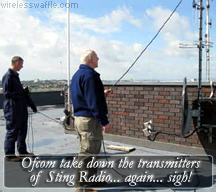 We recently discussed the idea that pirate radio could move to small-scale DAB radio services, or conversely that the closure of regular FM services might open up the FM band as a playground for even more pirates. But could there be yet another option... If Ofcom were to cease all enforcement activity on pirate radio (except in casese where it was causing interference to safety-of-life services) and let the illegal broadcasters run riot, the amount of intereference they would cause to legitimate stations would increase and this might be the incentive needed for those listeners to finally go out and buy a digital radio! So instead of continued enforcement, why not leave the pirates alone and see if that has the desired effect (in this case meaning 'forcing a move to digital radio').
We recently discussed the idea that pirate radio could move to small-scale DAB radio services, or conversely that the closure of regular FM services might open up the FM band as a playground for even more pirates. But could there be yet another option... If Ofcom were to cease all enforcement activity on pirate radio (except in casese where it was causing interference to safety-of-life services) and let the illegal broadcasters run riot, the amount of intereference they would cause to legitimate stations would increase and this might be the incentive needed for those listeners to finally go out and buy a digital radio! So instead of continued enforcement, why not leave the pirates alone and see if that has the desired effect (in this case meaning 'forcing a move to digital radio').
